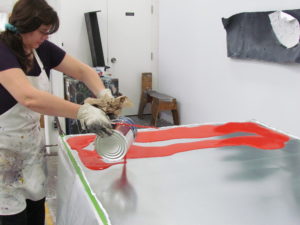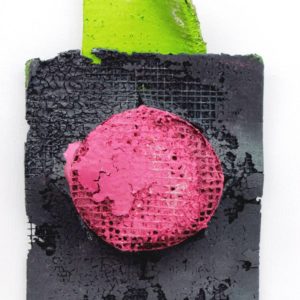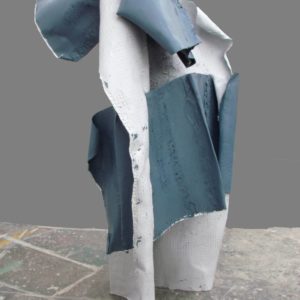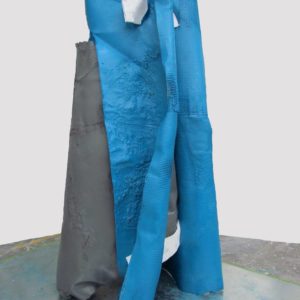The Others
 Exploring the ‘Unknown Territory’ of Painting with Laurie-Lynn McGlynn
Exploring the ‘Unknown Territory’ of Painting with Laurie-Lynn McGlynn
As a contemporary painter, Laurie-Lynn McGlynn has self-proclaimed that she is tied to the history of painting and the formal language that has defined it for centuries. However more recently her work has been communicating change and evolution. Moving away from the 2-Dimensional canvas, Laurie-Lynn has strayed into ‘unknown-territory’ with her 3-dimensional works.
Laurie-Lynn lives and works in Canada and is a MFA candidate with the Nova Scotia College of Art & Design. She was most recently selected to take part in The Other Art Fair Brooklyn and will show her work at the fair in November 8-11 at the Brooklyn Expo Center.
What are the major themes you pursue in your work?
As a contemporary painter, I feel there is no better time than now to challenge historical notions and ideologies that no longer prevail in art making. Therefore I can explain my current practice as addressing two concerns: Firstly, to explore the formal relationships of the pictorial surface by negating the confines of the wall. Secondly, to reference the built environment and its inevitable deterioration, and here lies the parallel to the human condition and our mortality.
As a painter, I am concerned with the physicality of and tension between paint and its support. This is manifested through paint handling and the resultant textural surface left behind on both canvas or wire mesh. As a process-based painter, I live for the materiality of paint, particularly the plasticity of acrylic paint and its malleable properties.
So, in a nut-shell…I use a variety of techniques to manipulate paint, to make free-standing, 3-dimensional paintings….not ordinary paintings… Paintings with mass, volume and magnitude which interact with the space around them.
How did you first get interested in your medium, and what draws you to it specifically?
Acrylic being one of the most efficient of painting mediums, is the reason I was first drawn to it. While in the BFA program, I had the opportunity to explore anything that would hold pigment such as the most common being oil, acrylic/latex/polymer, water, egg yolk, but also tea, chalk, ink, and other organic materials with mixed media. I enjoy the properties and forgivable qualities of oil paint but my 3-dimensional paintings use acrylic paint since it is the polymer base that I find interesting to work with… Basically because this paint is really just liquid plastic and it is somewhat amusing to place an industrially designed paint within the world of fine art! Also, due to the process of heat induction that is applied to the wet paint, acrylic works best for this purpose.
How has your style and practice changed over the years?
Having approached painting first through the experiential learning of a self-taught Artist and then academically trained, I would say that my current practice communicates a great deal of change change and evolution. I began painting whatever I could see in front of me, then I began to paint what others saw in front of them. Now I paint what I feel and hope to share that feeling with others, even if the feeling they get from the work is different from mine. I guess like most Artists I’m just happy to evoke something from the viewer!
Can you walk us through your process? Do you begin with a sketch, or do you just jump in?
My process begins with a series of thoughtful intention followed by reasoning out the choices. The former consists of a seed of an idea, followed by research which could be in the form of books, personal photographs, internet etc. Reasoning out the choices is just that… Is this a possibility? And can this be achieved based on many factors? (space limitations; time frame; costs of materials etc.)
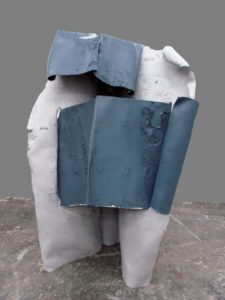
As a way to thematically reference the built environment and structural deterioration, I employ various external processes that manipulate the paint, thereby exposing its innate strengths and weaknesses. The application of scorches, rips and tears, evokes a sense of damage to the point of exposing the infrastructure beneath the layers of paint. The grid-like pattern that emerges from the wire mesh communicates an industrial interplay of structural re-bar or lathe and plaster, allowing the work to reference both time and memory. While the outer layers act as crumbling exteriors, order and structural integrity is suggested by the repetition of the interior grid.
Who are some of your favorite artists, and why?
Robert Morris’s minimalism and large geometric forms. Imi Knoebel’s ‘De-familiarization’ of the formal elements of painting with free-standing panels. Helio Oiticica for his use of color and spatial concerns particularly his interactive pieces. Lygia Clark, like Oiticica she was another Brazilian Artist that was ahead of her time and challenged the accepted norm in art making. I could name many others, but not sure how much room I have!

